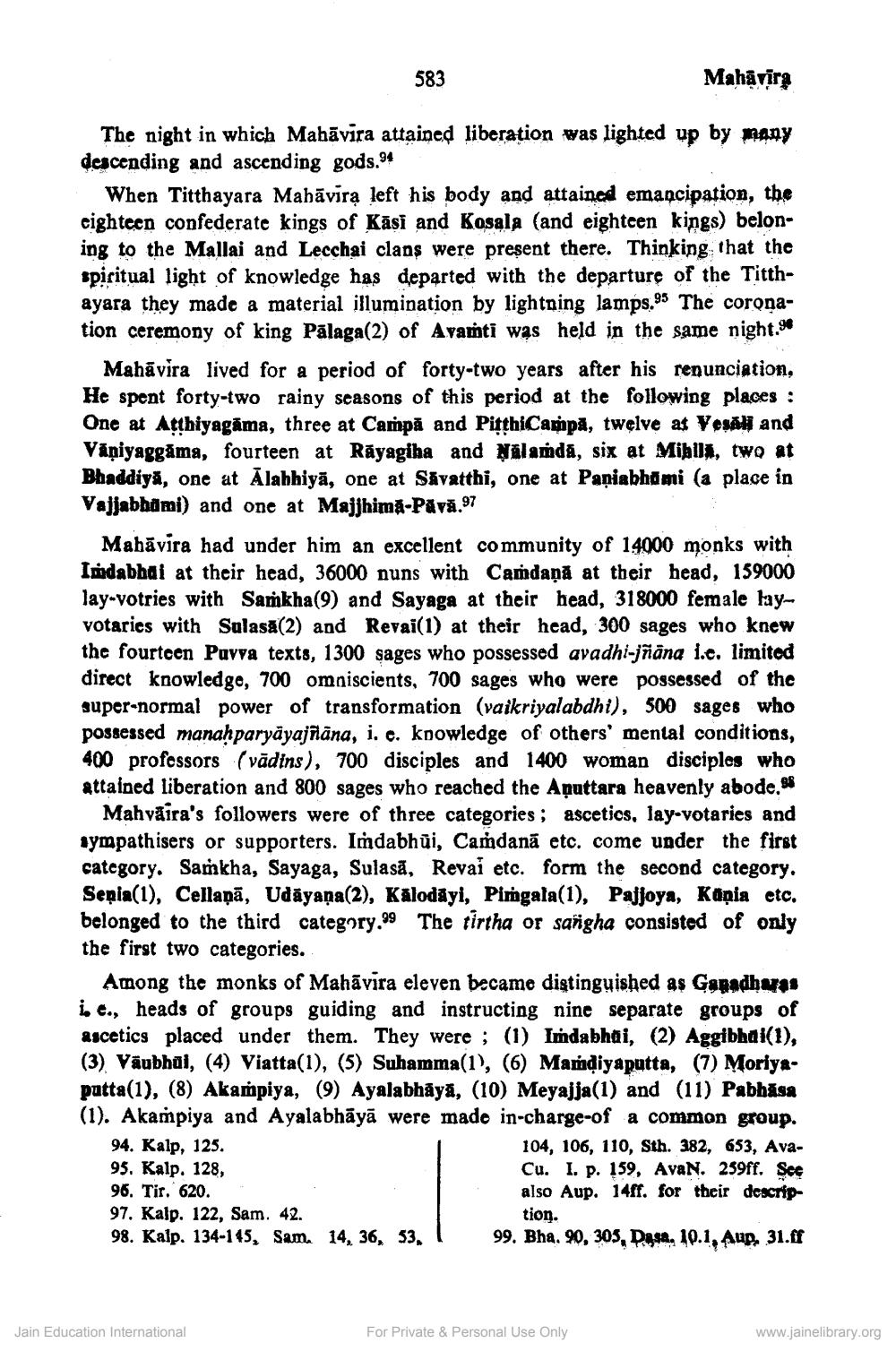________________
583
Maharira
The night in which Mahāvira attained liberation was lighted up by many descending and ascending gods.94
When Titthayara Mahāvirą left his body and attained emancipation, the cightecn confederate kings of Kāsi and Kosala (and eighteen kings) beloning to the Mallai and Lecchai clans were present there. Thinking that the spiritual light of knowledge has departed with the departure of the Titthayara they made a material illumination by lightning lamps.98 The coronation ceremony of king Pālaga(2) of Avamti was held in the same night.
Mahāvira lived for a period of forty-two years after his renunciation, He spent forty-two rainy seasons of this period at the following places : One at Atthiyagama, three at Campă and PitthiCampá, twelve at Vesal and Vāpiyaggama, fourteen at Rāyagiha and Nálamda, six at Mibuli, two at Bhaddiya, one at Alabhiyā, one at Săvatthi, one at Paniabhdmi (a place in Vajjabhämi) and one at Majjhima-Păvă.97
Mahā vira had under him an excellent community of 14000 monks with Indabhai at their head, 36000 nuns with Camdapă at their head, 159000 lay-votries with Samkha(9) and Sayaga at their head, 318000 female layvotaries with Sulasa (2) and Revai(1) at their head, 300 sages who knew the fourteen Pavva texts, 1300 sages who possessed avadhi-jñāna 1.c. limited
ct knowledge, 700 omniscients, 700 sages who were possessed of the super-normal power of transformation (vaikriyalabdhi), 500 sages who possessed manah paryāyajñāna, i. e. knowledge of others' mental conditions, 400 professors (vādins), 700 disciples and 1400 woman disciples who attained liberation and 800 sages who reached the Aputtara heavenly abode.
Mahvăira's followers were of three categories ; ascetios, lay-votaries and sympathisers or supporters. Imdabhūi, Camdanā etc. come under the first category. Samkha, Sayaga, Sulasă, Revai etc. form the second category. Senia(1). Cellapā, Udayana(2), Kalodāyi, Pirgata(1), Pajjoya, Kaņia etc. belonged to the third category.39 The tirtha or sangha consisted of only the first two categories.
Among the monks of Mahāvīra eleven became digtinguished as Ganadhani in c., heads of groups guiding and instructing nine separate groups of ascetics placed under them. They were ; (1) Imdabhai, (2) Aggibhak(1), (3) Väubhūi, (4) Viatta(1), (5) Suhamma(1), (6) Mandiyaputta, (7) Moriyaputta(1), (8) Akampiya, (9) Ayalabhāyā, (10) Meyajja(1) and (11) Pabhāsa (1). Akampiya and Ayalabhāyā were made in-charge-of a common group. 94. Kalp, 125.
104, 106, 110, Sth. 382, 653, Ava95. Kalp. 128,
Cu. I. p. 159, AvaN. 259ff. See 96. Tir. 620.
also Aup. 14ff. for their descrip97. Kalp. 122, Sam. 42.
tion. 98. Kalp. 134-145, Sam. 14, 36, 53, 99. Bha, 90, 305, Dasa, 10.1, Aup. 31.ff
Jain Education International
For Private & Personal Use Only
www.jainelibrary.org




